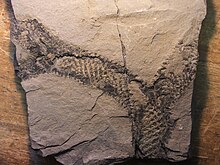
Back هيشوميات Arabic Lepidodendrales Azerbaijani Lepidodendrales German Lepidodendrales Spanish پولکدرختسانان Persian Lepidodendrales Finnish Lepidodendrales French Lepidodendrales Galician Pikkelyfák Hungarian Lepidodendrales Italian
| Lepidodendrales Temporal range:
| |
|---|---|

| |
| A bifurcation in Lepidophloios | |
| Scientific classification | |
| Kingdom: | Plantae |
| Clade: | Tracheophytes |
| Clade: | Lycophytes |
| Class: | Lycopodiopsida |
| Order: | †Lepidodendrales |
| Genera | |
| |
Lepidodendrales (from the Greek for "scale tree") or arborescent lycophytes are an extinct order of primitive, vascular, heterosporous, arborescent (tree-like) plants belonging to Lycopodiopsida. Members of Lepidodendrales are the best understood of the fossil lycopsids due to the vast diversity of Lepidodendrales specimens and the diversity in which they were preserved; the extensive distribution of Lepidodendrales specimens as well as their well-preservedness lends paleobotanists exceptionally detailed knowledge of the coal-swamp giants’ reproductive biology, vegetative development, and role in their paleoecosystem. The defining characteristics of the Lepidodendrales are their secondary xylem, extensive periderm development, three-zoned cortex, rootlike appendages known as stigmarian rootlets arranged in a spiralling pattern, and megasporangium each containing a single functional megaspore that germinates inside the sporangium. Many of these different plant organs have been assigned both generic and specific names as relatively few have been found organically attached to each other. Some specimens have been discovered which indicate heights of 40[1] and even 50 meters[2] and diameters of over 2 meters at the base. The massive trunks of some species branched profusely, producing large crowns of leafy twigs; though some leaves were up to 1 meter long, most were much shorter, and when leaves dropped from branches their conspicuous leaf bases remained on the surface of branches. Strobili could be found at the tips of distal branches or in an area at the top of the main trunk. The underground organs of Lepidodendrales typically consisted of dichotomizing axes bearing helically arranged, lateral appendages serving an equivalent function to roots. Sometimes called "giant club mosses", they are believed to be more closely related to extant quillworts based on xylem, although fossil specimens of extinct Selaginellales from the Late Carboniferous also had secondary xylem.[3][4]
- ^ A. V. Lopatin (2012). Палеонтологический музей имени Ю.А. Орлова (The Orlov Museum of Paleontology). Moscow: PIN RAN. p. 56. ISBN 978-5-903825-14-1. Retrieved 2020-10-05.
- ^ V. V. Alekhin (1961). Geografiia rastenii s osnovani botaniki (Geography of plants and basics of botany). Gos. nauchno-pedagog. izd-vo. p. 167. Retrieved 2020-10-05.
- ^ Wickell, David; Kuo, Li-Yaung; Yang, Hsiao-Pei; Dhabalia Ashok, Amra; Irisarri, Iker; Dadras, Armin; De Vries, Sophie; De Vries, Jan; Huang, Yao-Moan; Li, Zheng; Barker, Michael S.; Hartwick, Nolan T.; Michael, Todd P.; Li, Fay-Wei (2021). "Underwater CAM photosynthesis elucidated by Isoetes genome". Nature Communications. 12 (1): 6348. Bibcode:2021NatCo..12.6348W. doi:10.1038/s41467-021-26644-7. PMC 8566536. PMID 34732722.
- ^ "Selaginellales". ScienceDirect. 2009. Retrieved Jan 17, 2022.
© MMXXIII Rich X Search. We shall prevail. All rights reserved. Rich X Search